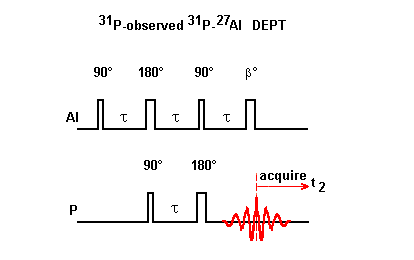Distortionless Enhancement by Polarization Transfer
Doddrell and coworkers designed the DEPT sequence where the discrimination of J-coupled resonance lines relies on the flip angle beta rather than a refocusing delay delta in INEPT. Since the flip angle beta is independent of J, whereas the delay between pulses depends on J, the DEPT experiment is superior for spectral editing.

Compared to the INEPT experiment, there are 180° pulses applied simultaneously with 90° pulses.
Some NMR references about Distortionless Enhancement by Polarization Transfer pulse sequences involving half-integer quadrupole spins, (*) those containing the pulse-sequence diagram:
-
C. A. Fyfe, K. C. Wong-Moon, Y. Huang, and H. Grondey
INEPT experiments in solid-state NMR,
J. Am. Chem. Soc. 117, 10397-11398 (1995).
Related bibliography
-
D. M. Doddrell, D. T. Pegg, and M. R. Bendall
Distortionless enhancement of NMR signals by polarization transfer,
J. Magn. Reson. 48, 323-327 (1982).
